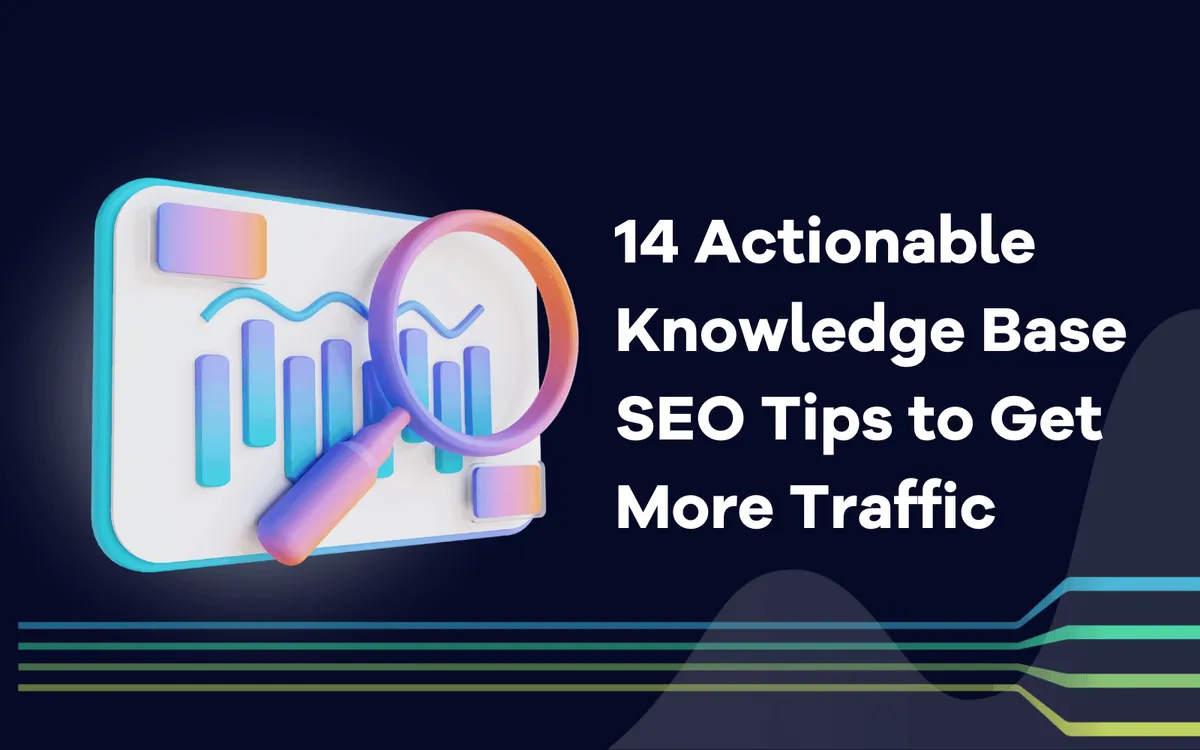
14 Actionable Knowledge Base SEO Tips to Get More Traffic

Julia Serdiuk
February 26, 2024
Boost your website's traffic with these 14 actionable Knowledge Base SEO tips. Learn effective strategies for increased visibility and engagement.
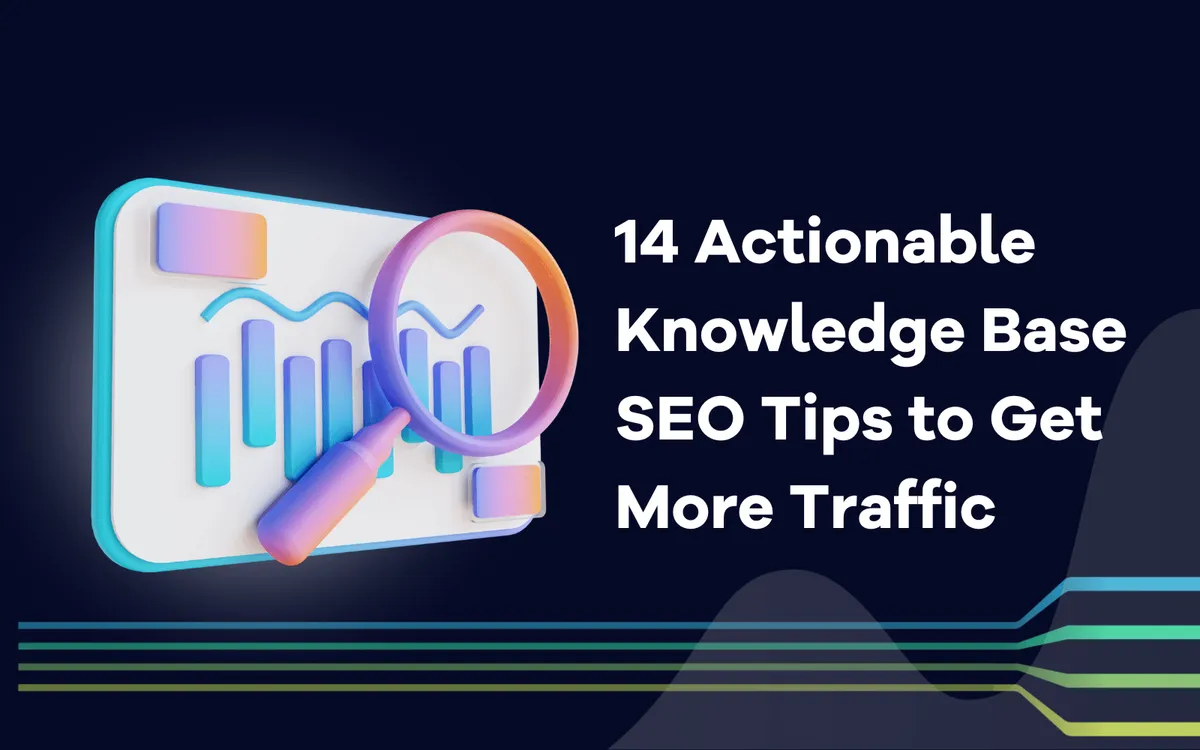
A well-crafted knowledge base is more than just a fantastic tool for customers who love to find answers independently. At the same time, by implementing knowledge base SEO best practices you can attract new leads directly from search engines. By optimizing articles for keyword phrases a potential customer uses for search, you can get higher in the SERP and bring target organic traffic.
If that’s what you are looking for, see our 14 practical tips to make that happen in 2024. But first, let’s learn how it really works. 👇
Importance of knowledge base SEO for businesses
Search engine optimization (SEO) is one of the basic features of the best knowledge base software. Besides dishing out helpful info to your clients, those optimized articles pack a bunch of awesome perks for your company! Here's the rundown on what you can expect:
Targeting long-tail keywords. This is one of the easiest ways to attract more qualified leads. With a clear vision of your client's journey, you can quickly identify them and optimize knowledge base articles accordingly.
Getting links from other websites. Content marketers tend to mention links to high-quality content only in their articles. But writing it requires many resources. Good to know, you don't need to because having an optimized knowledge base means having accurate, well-researched, and informative content.
Helping search engines index your knowledge base content more effectively. The hierarchical structure of the knowledge base with all the categories, tags, and topics makes it easy for Google and Bing to understand and crawl your website.
Building a reputation as an expert source of info. Creating a knowledge base is excellent for showing expertise on a particular topic. All those informative go-to guides, instructions, and video tutorials written by product experts contain much richer data than blog articles.
Improving visitors' behavior metrics. Knowledge base articles with tons of valuable information are a great magnet for keeping your visitors' attention. The more time they spend reading - the better search engine ranking your website gets.
Content part of optimizing your knowledge base for Google
Identify relevant keywords for your knowledge base SEO
Keywords are the heart of every SEO strategy. They are terms people use to search for info like "How to create a knowledge base" or "improve page load time." Some of them are googled more, some less. We aim to find keywords with a good search volume relevant to your product and include them the correct number of times in your knowledge base articles.
As a result, the next time people google something related to your product, they'll see your articles first.
How to identify those keywords
Start by picking the keywords related to your business or regularly in your articles.
Google them to look at keyword suggestions in the search bar and the bottom of the page.
Use Google Adwords to see traffic on what keywords you already have.
Check your competitors' keywords by copy-pasting their knowledge base articles to tools like Semrush and Ahrefs.
The same tools can help you find related keywords to enrich your list.
Then, divide the collected keywords into different topic groups and define whether to add them to the existing article (if its content matches) or create a new one.
Pro tip: Mind the Keyword Difficulty (KD). Keywords with up to 30-40 KD have better ranking potential. The higher the KD, the more difficult it is to rank your knowledge base.
Structure article content with subheadings, lists, and tables
So, you created a knowledge base article. Search engines use special robots to scan your text to understand what you wrote and rank it accordingly. Here works the same rule as with human readers - the better structure your content has, the easier it is to understand.
Ensure that in addition to keywords, your knowledge base documentation pages have:
The descriptive headline and H2-H3 subheadings make your content as easy to scan.
Short paragraphs. The recommended length of a paragraph is 250 words and three sentences at maximum. Longer sentence texts have a higher bounce rate.
Lists. Short pieces of info in a numbered list or bullet points format are another way to ease human and robot understanding of your article.
Images, videos, audio. Ensure each has a descriptive title, ALT, and file format that fastens page loading times. Adding these elements is a question of user experience first. Multimedia content keeps visitors engaged and increases their time on the page. As a result, you have better SERP positions.
Add an FAQ section
The FAQ section in your knowledge base articles can boost your SEO. It is a direct answer to a question that your readers google. For instance, instead of vying for a top spot with the keyword "plumbing tips," you can answer questions like "What tools do I need to replace a faucet?" and attract a more focused audience.
The straightforward answer to such a question rolls out the red carpet for search engines to find and showcase your article. What is more, it’s easy to make a well-planned FAQ section if you can ask your team members from the customer support to share frequently-asked questions with the help of communication tools like Monday.com alternatives.
Here is what this website block can look like:
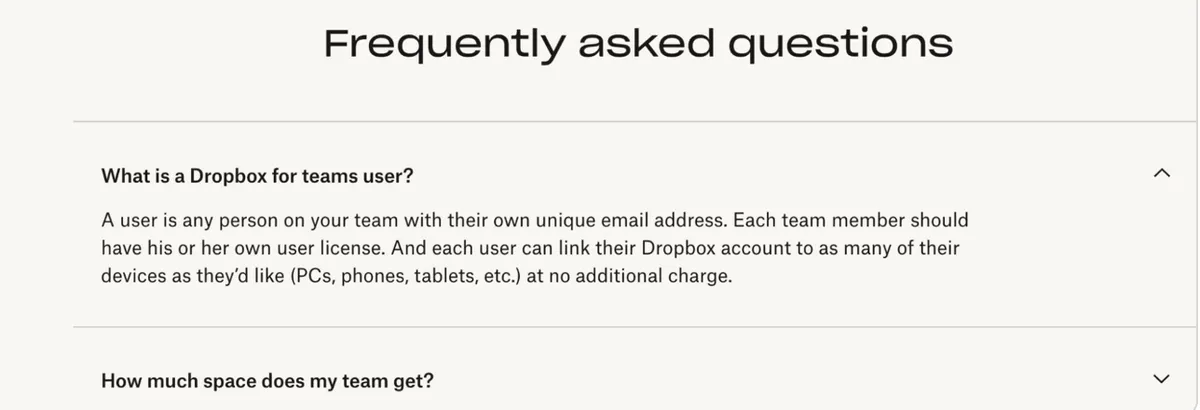
Source: Semrush
Pro tip: Adding special Schema markup to your FAQ section increases your chances of appearing in snippets or the "People also ask" section.
How to search FAQs?
Dive into Google's People Also Ask section, Google's Keyword Planner, Semrush, AnswerThePublic, etc., tools to find out exactly what your audience is curious about.
Write a relevant answer. It should be a paragraph in length and include relevant keywords. Keep it simple, relevant, and helpful.
Ensure your knowledge base articles have a relevant length
The ideal length of an article varies depending on the topic, audience, and competition. But in terms of SEO, long-form content ranks better, significantly articles from 1000 to 2,500 words. Why? There is more scope for including relevant keywords and detailed topic coverage.
At the same time, the 600-700 word range is a good starting point for effective knowledge base articles. Feel free to go longer if the complexity of the topic warrants it.
The best way to balance good user experience and SEO requirements in length is to create detailed articles that address one specific user question.
Optimize article title, meta description, and URL
Optimizing your article starts with strategically placing the main keyword and following best practices for each structural element. Below, discover essential tips for weaving in your primary keyword and optimizing critical parts of your article:
The knowledge base article URL should be short (1-4 words). Ensure it doesn't include _ or @ symbols. Separate terms with a dash -.
The page title should also contain the main keyword and be kept to 65 characters, ensuring it differs from Headline 1.
The meta description should briefly summarize what your article covers and complement the title. Keep it engaging; for example, include part of the answer to a 'how-to' question to entice readers to explore your content further. This element should be at most 160 characters in length.
Add the main keyword into the first paragraph. Google may use this section to replace the meta description in search results, making an optimized introduction crucial.
Build internal links between your knowledge base articles
Internal linking between your knowledge base articles is a powerful navigation tool for your readers. For example, orange parts of text in the Semrush article are inbound links leading visitors to relevant articles:
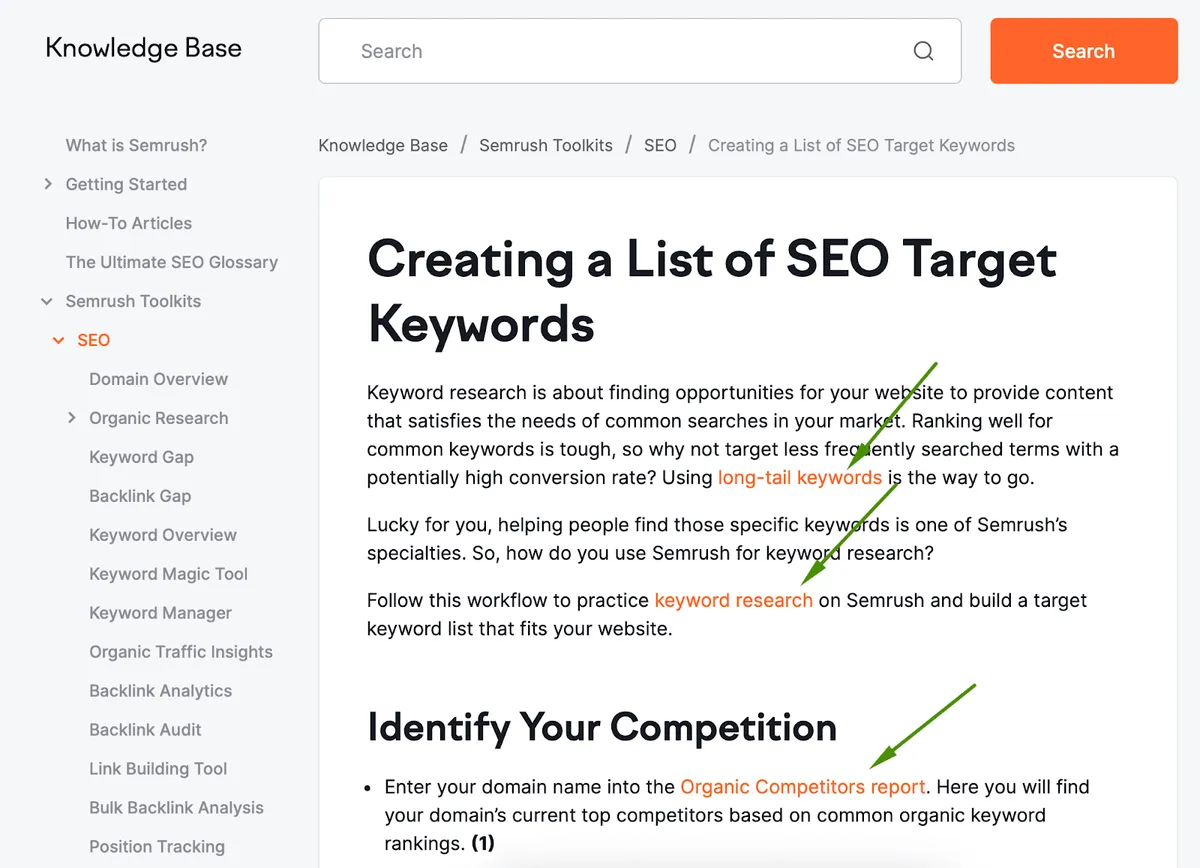
Source: Semrush
Internal and external link profiles help search engines understand more about your website and where it is within the industry. But don't go overboard stuffing your articles with tons of links. It's better to stick to 2-3 links per 1000 words throughout the text, except for the first paragraph.
Pro tip: When including external links, choose reputable websites with strong rankings, especially those from the education sector or major players like Forbes or Gartner.
Allow customers to leave comments under your posts
We still need to determine the complete list of parameters search engines use to rank websites. However, there are proven tactics to influence their decisions by improving visitor behavior metrics, such as allowing readers to comment on your knowledge base articles like blog posts. Doing so creates an excellent space for knowledge exchange and discussion among users.
For Google and Bing, comments under an article indicate readers' interest in its content, leading to better SERP positions.
Refresh content regularly
Refreshing your knowledge base articles has the same power as the reboot button on your old laptop - it makes everything more relevant. Content updates signal that your site is active.
Since search engines love fresh content, they give it an additional boost in rankings.
How often should you do this? Try to review your content at least once every six months.
For example, if you've got an article on "The Top Social Media Trends in 2023," you'll want to update it for 2024 as the year ends. Similarly, if a software update rolls out new features, ensure your how-to guides and tutorials reflect these changes.
It is also an excellent tactic to keep your readers returning for more.
Pro tip: Don’t update the publication date. Just add “Updated 23/04/2024 data at the end of the post.”
Tech part of your knowledge base SEO optimization
Improve page loading time
Website speed is everything for SEO. To check it, visit Google's free page speed testing tool. Ideally, the load time of your knowledge base articles should be within three seconds. If it is more, there is a chance of being penalized by Google. Visitors tend to abandon such websites as well. This is how the bounce rate grows - one more factor lowering your SERP positions.
Indeed, keeping up with the speed limit can be challenging, given the amount of multimedia that knowledge base posts usually contain.
Here is some advice on how to improve the page load time of your knowledge base:
compress images and use HTML and CSS files,
activate browser caching,
decrease your server's response time to below 200 milliseconds.
Optimize knowledge base content for mobile readers
One of the latest updates from Google now prioritizes mobile-responsive websites in mobile search results. This is a great change considering the growing number of mobile users.
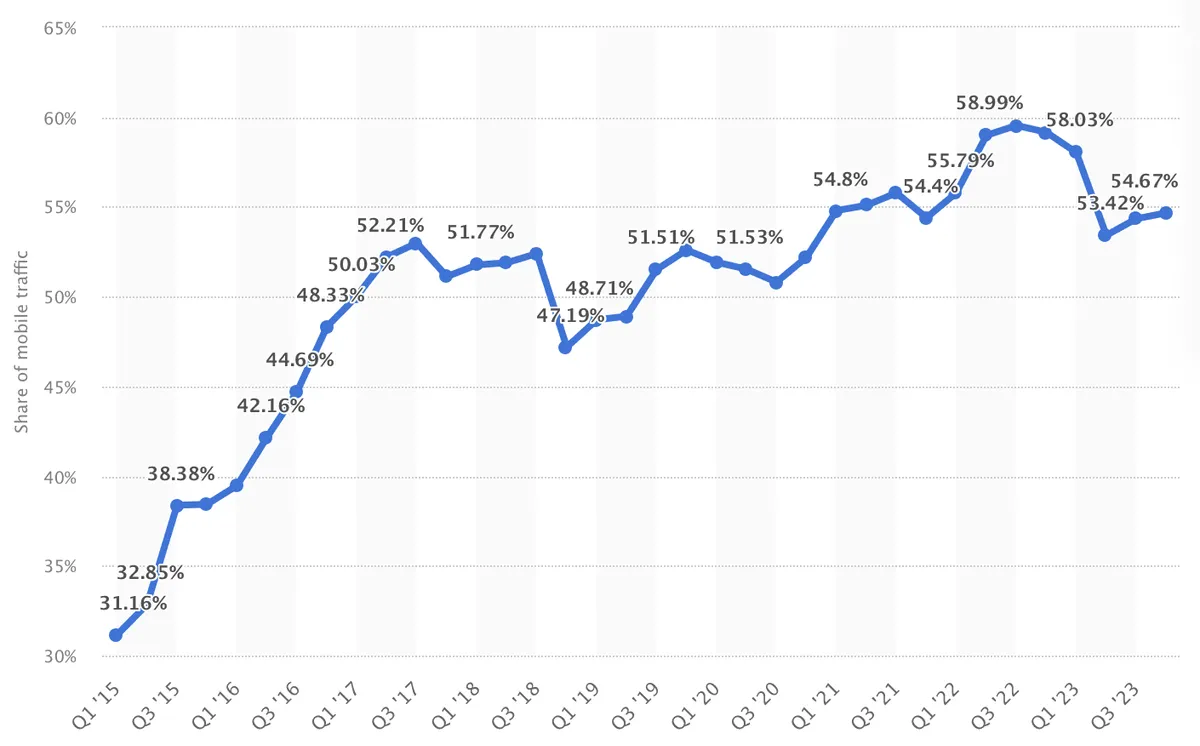
Percentage of mobile device website traffic worldwide from 1st quarter 2015 to 4th quarter 2023. Image source.
This means smartphone users will only see responsive knowledge base articles in SERP.
So, ensure your text is readable, buttons are easy to tap, and navigation is smooth for clients reading your articles on their phones. There is always an opportunity to check it with Google's free mobile-friendly testing tool.
Utilize markup from Schema.org
It is microdata explaining to Google the key points of your articles. Considering the knowledge base case, it is:
navigation through the structure of your knowledge base,
breadcrumbs to present the structure of the content,
search bar,
author name,
videos,
knowledge base in the SERPs itself.
There are special marks in the knowledge base article code, so visitors don't see them.
Once a search engine defines your knowledge base, figures out what someone's asking for, and connects the dots, it can deliver better results.
Elevate Visibility With XML Sitemap
XML sitemap is a list of URLs of your knowledge base. Google uses it to find and index its pages.
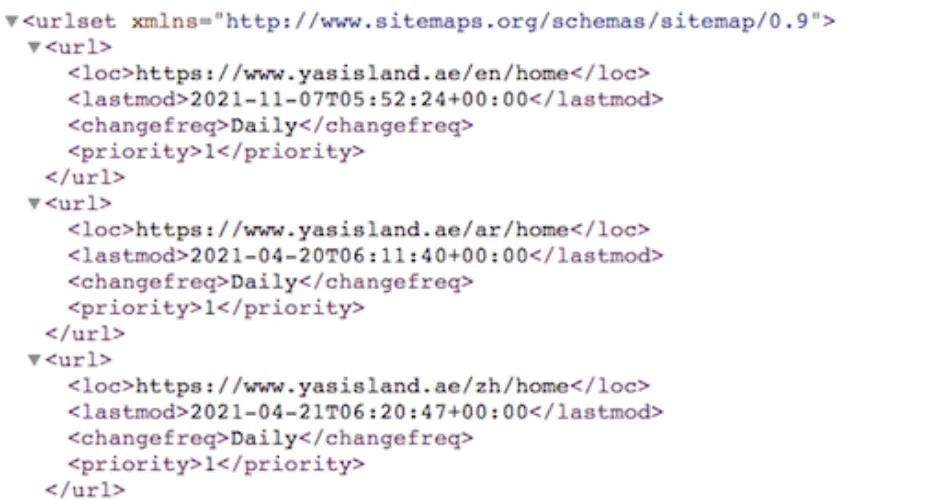
Source : Seosherpa
It offers details on the most recent update and the frequency of article revisions.
Creating a sitemap is necessary when creating many knowledge base pages without a rich external and internal link profile or using complicated architecture.
Once an XML sitemap is ready, it is time to submit it to Google Search Console. This signals the search engine to dispatch its crawlers to your site. Do this when you add a new article or section to your knowledge base.
HTML sitemap
It is a map of your website, but this time for humans. Usually, a link to the HTML sitemap is located in the page footer. It leads visitors to a list of your website's pages or knowledge base.
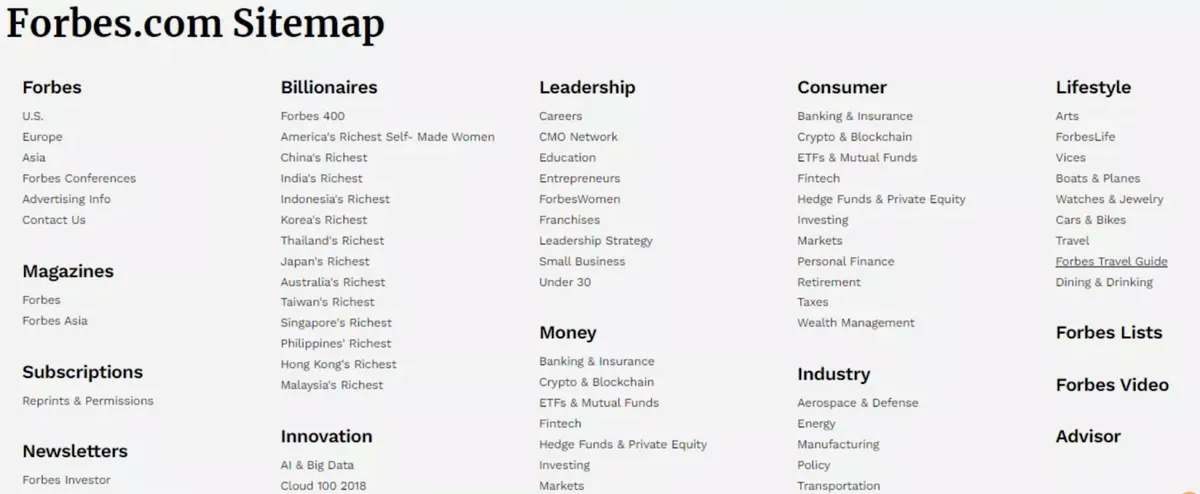
Source: Netpeak
This proven UX element helps users to navigate if they need help.
Robots.txt
Robots.txt is another file explaining search engine robots and whatnot to index within your knowledge bases. It can be internal search results pages, duplicates, or images.
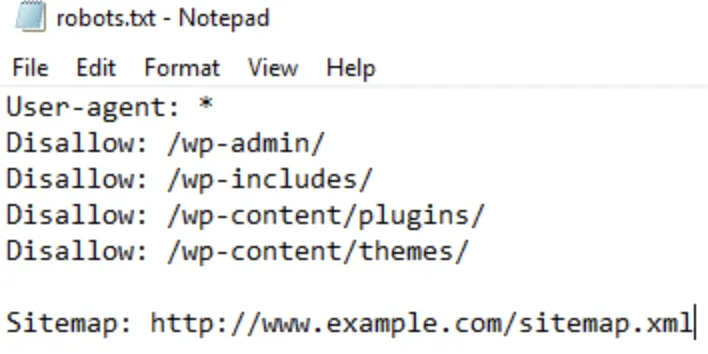
Check if you have it by typing your site URL in the browser followed by /robots.txt. If there is no such file, you should create it manually. You'll need a text editor and search for relevant Google instructions.
But it is better to delegate this task to your developers.
To summarize
You've got a lot of tips here, but consistency is key. Aim for a check-up every six months. Focus on easy navigation, mobile-friendliness, and clean URLs. Keep content relevant, avoid duplicates, ensure quick page loads, and secure your site. A good link profile and engaging site layout matter, too.
This quick audit helps you stay on top of SEO and boosts customer service, attracting new ones. Always prioritize their needs, refining your content to meet them effectively.
Related blog posts
The Hidden Flaws in Search Volumes and How to Solve Them
Learn how AI Search Volume delivers reliable search volumes by combining GKP, GSC, and Trends so that you can prioritize the right keywords.
1 July 2025
AI Overviews Are Taking Over SERPs
From traffic drops to decreasing CTRs, AI Overviews are shaking up SEO. Learn what is happening and how AccuRanker helps you track AIO.
25 June 2025
How AccuRanker’s AI Models Fix Inaccurate SEO Data
Struggling with unreliable SEO data? Discover how AccuRanker’s CTR, Search Intent, Search Volume, and Share of Voice deliver accurate insights.
1 June 2025




